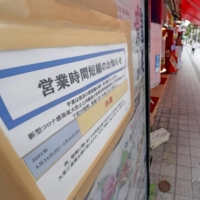Prefectural governors on Saturday urged the central government to enhance countermeasures against mutated strains of the coronavirus, including a variant from India, and to provide support to ensure smooth vaccinations.
At a videoconference, the National Governors’ Association called on the state to take thorough measures to reduce the number of new infections to a level that would not bring about another wave of the virus.
“We’re still in a situation that doesn’t warrant optimism, with the number of severely ill coronavirus patients and hospital bed occupancy rates remaining high,” the association said, demanding that the central government clarify its countermeasures.
The association proposed that the central government strongly call on people to avoid travel to areas where infections are surging as much as possible, as well as take effective measures, such as covering travel cancellation fees entirely.
To contain the variant first detected in India, which is believed to be even more contagious than the currently dominant variant first found in the U.K., the central government should strengthen border control and help local governments improve their testing capacities, the association said.
In order to speed up the vaccine rollout, the association also asked for more staff members and financial aid.
Forty-three of the 47 prefectural governors attended the videoconference, held after the central government decided Friday to extend its coronavirus state of emergency for Tokyo, Osaka and other prefectures until June 20. The emergency was slated to expire at the end of May.
The government made the decision in view of lingering shortages of hospital beds and other factors although new infection cases are on a declining trend.
Noting that the Indian variant has spread among young people in Britain, Mie Gov. Eikei Suzuki warned, “The same thing will probably happen in Japan, triggering a big wave of infections.”
Governors also called on the central government to clarify the schedule of vaccine distribution to local governments and the amount of vaccines to be allocated, setting their eyes on the start of inoculations of people under the age of 65.
The vaccination drive now mainly targets older people, the second priority group, after the first priority group of medical workers.
In a time of both misinformation and too much information, quality journalism is more crucial than ever.
By subscribing, you can help us get the story right.
SUBSCRIBE NOW



